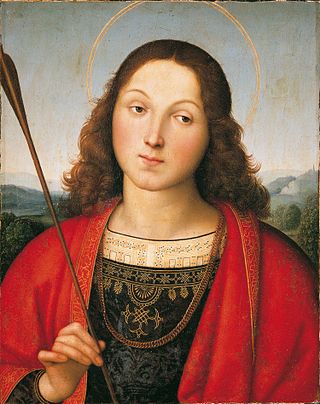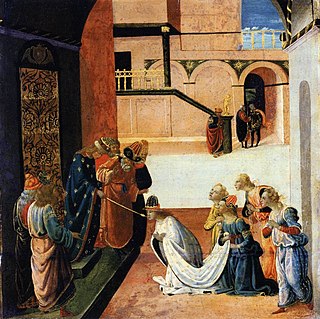
Saint Sebastian is a painting of the early Christian saint and martyr Saint Sebastian painted c. 1501–1502 by the Italian High Renaissance artist Raphael. Part of his early works, it is housed in the Accademia Carrara of Bergamo, Italy. In 2022 the painting was included in a exhibition held at the National Gallery in London.

The Madonna and Child Enthroned with Saints, also known as the Colonna Altarpiece, is a painting by the Italian High Renaissance artist Raphael, executed c. 1503-1505. It is housed in the Metropolitan Museum of Art of New York City. It is the only altarpiece by Raphael in the United States.

The Madonna of the Pinks is an early devotional painting usually attributed to Italian Renaissance master Raphael. It is painted in oils on highly toxic yew wood, a first for a Raphael, and now hangs in the National Gallery, London.

Madonna in Glory with Seraphim is a tempera painting on panel by the Italian Renaissance painter Sandro Botticelli, executed c. 1469–1470. It is housed in Galleria degli Uffizi.

La Belle Jardinière, also known as the Madonna and Child with Saint John the Baptist, is a painting started by the Italian High Renaissance artist Raphael, and finished by Ridolfo del Ghirlandaio, that depicts the Madonna, a young Christ, and a young John the Baptist. It is believed to have been commissioned by the Sienese patrician Fabrizio Sergardi in approximately 1507. It is currently displayed in the Louvre Museum in Paris, France.

The Conestabile Madonna is a small painting by the Italian Renaissance artist Raphael for the Conte della Staffa, executed c. 1502–1504. It was likely the last work painted by Raphael in Umbria before moving to Florence.

The Garvagh Madonna is an oil painting by the Italian Renaissance artist Raphael, dating to c. 1509–1510. It depicts the Virgin, the Christ Child and the infant John the Baptist, and is one of many paintings by Raphael with this trio. It is from early in the artist's third, or Roman period, in which distinctive changes are seen from his Umbrian or Florentine period in style and use of colour, with the introduction of more natural subjects and settings.

The Madonna of Bogota is a painting of the Madonna and Child, rediscovered in Bogotá, Colombia in 1938, that has been attributed to Raphael. It was brought to present day Colombia by the Spanish crusader and conquistador Gonzalo Suárez Rendón, who was awarded the painting by Emperor Charles V as a war trophy after the Battle of Pavia.
Events from the year 1508 in art.

Jacopo del Sellaio (1441/42–1493) was an Italian painter of the early Renaissance, active in his native Florence. His real name was Jacopo di Arcangelo. He worked in an eclectic style based on those of Botticelli, Filippino Lippi, and Domenico Ghirlandaio. The nickname Sellaio derives from the profession of his father, a saddle maker.

The Eleusa is a type of depiction of the Virgin Mary in icons in which the Christ Child is nestled against her cheek. In the Western Church the type is often known as the Virgin of Tenderness.

The Madonna del Prato, formally Madonna with the Christ Child and Saint John the Baptist, is an oil on board painting by Raphael, created in 1506, now held in the Kunsthistorisches Museum in Vienna. It is also known as the Madonna del Belvedere after its long residence in the imperial collection in the Vienna Belvedere.

The Portrait of Pope Leo X with two Cardinals, also known as Portrait of Pope Leo X with the cardinals Giulio de' Medici e Luigi de' Rossi, is a painting by the Italian High Renaissance master Raphael, executed c. 1518-1520. It is housed in the Uffizi Gallery of Florence and currently on exhibition at the Palazzo Pitti.

The Madonna of the Candelabra is a Madonna painting by the Italian Renaissance artist Raphael, dating to about 1513-1514 and is in the collection of the Walters Art Museum in Baltimore.

The Campori Madonna is an oil-on-panel painting executed ca. 1517–18 by the Italian Renaissance painter Antonio da Correggio.

Mary Magdalene is an oil on panel painting of Mary Magdalene, dating to around 1500 and now in the Galleria Palatina in Florence - it has featured in its inventory since 1641. It is now attributed to Perugino. It is modelled on his wife Chiara Fancelli, who also modelled for several of his Madonnas. It is comparable to his Madonna and Child with St John the Baptist and St Catherine of Alexandria (Louvre), of similar date and with a similar dark background.

The Immaculate Conception with St John the Evangelist is a c. 1585 oil on canvas painting of the Immaculate Conception by El Greco.

The Madonna of the Baldacchino is a c.1506-1508 oil on canvas holy conversation-style painting by Raphael, now in the Galleria Palatina in Florence.

The 'Diotallevi Madonna is an oil on panel painting by Raphael, created c. 1504. It is held in the Bode Museum, in Berlin, where it entered in 1841-1842 from Marquess Diotallevi's collection in Rimini. Previously attributed to Raphael's teacher Perugino, almost all art historians now attribute it to Raphael, with the exception of Adolfo Venturi who attributes it and parts of Perugino's Madonna della Consolazione to an anonymous, "Master of the Diotallevi Madonna".

The Bridgewater Madonna is a religious painting by Raphael, dated 1507. Originally on oil and wood, but later transferred to canvas, it measures 81 by 55 cm. The picture is part of the permanent collection of the Scottish National Gallery in Edinburgh, on loan from the Duke of Sutherland Collection.



















